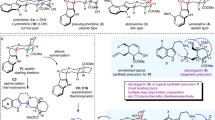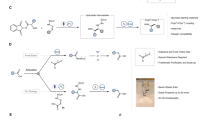Abstract
IT has been suggested by D. G. Harvey, E. J. Miller and W. Robson in a recent publication1 on the colour reactions of tryptophan and allied compounds—among them the alkaloid yohimbine—that the formation of a blue colour in sulphuric acid containing a trace of oxidizing agent is characteristic of the 4–carboxytetrahydro–β–carbolines. The presence in yohimbine of both tetrahydro–β–carboline and carboxylic acid (actually carbomethoxyl) residues has been recognized for some time, and it is clear from the formation in good yields of 2: 3–dimethylbenzoic acid from ketodihydroyobyrine2, and of harman and m–toluic acid from tetradehydroyohimbic acid3, that the carbomethoxyl must be attached to the yohimbine skeleton, which is as depicted, in ring E at position 16.
This is a preview of subscription content, access via your institution
Access options
Subscribe to this journal
Receive 51 print issues and online access
$199.00 per year
only $3.90 per issue
Buy this article
- Purchase on SpringerLink
- Instant access to full article PDF
Prices may be subject to local taxes which are calculated during checkout
Similar content being viewed by others
References
J. Chem. Soc., 153 (1941).
Barger and Scholz, Helv. chem. Acta, 16, 1343 (1933).
Hahn, Kappes and Ludewig, Ber., 67, 686 (1934).
Hahn and Stenner, Ber., 61, 278 (1928).
Hahn and Hansel, Ber., 71, 2192 (1938).
Author information
Authors and Affiliations
Rights and permissions
About this article
Cite this article
DEWAR, M., KING, F. Constitution of Yohimbine. Nature 148, 25 (1941). https://doi.org/10.1038/148025a0
Issue date:
DOI: https://doi.org/10.1038/148025a0



